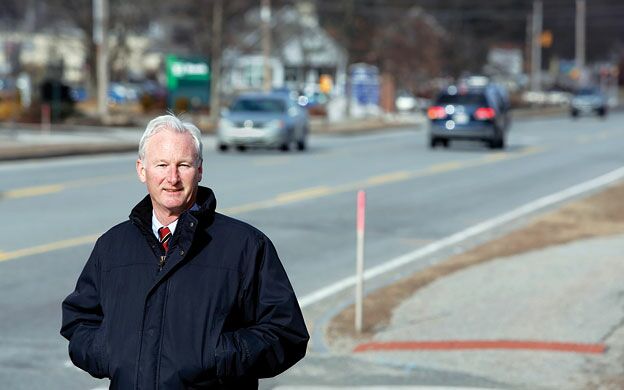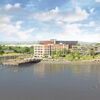Falmouth businesses boost Route 1 upgrade
 PHOTo / Tim greenway
Bill Sowles, the president of the Morong car dealership on Route 1 in Falmouth, hopes a plan to upgrade the town's commercial center will fly.
PHOTo / Tim greenway
Bill Sowles, the president of the Morong car dealership on Route 1 in Falmouth, hopes a plan to upgrade the town's commercial center will fly.
After at least 10 years of discussion, the Falmouth Town Council is going ahead with a plan that could substantially reshape the Route 1 commercial strip that now forms the business center in a town more often known for its excellent schools and upscale housing developments.
By June, the council expects to vote on a package of zoning changes that will permit mixed-used development, including residential, along the 1-mile corridor between the Maine Turnpike's Falmouth Spur, to the north, and the intersection of Route 88, to the south. Voters can expect to consider in June an extensive package of infrastructure improvements that will add medians and landscaping, limit exits and entrances to Route 1 and — perhaps — bury utility lines throughout the corridor.
Those infrastructure improvements are hailed by existing businesses, helping the project gather support among the town's commercial citizenry.
Bill Sowles has owned the Morong car dealership for years, and can remember Route 1 planning committees going back to 1984, “and I've served on all of them,” he says.
For most existing businesses, the big question was whether the town's plan will “ease the flow of traffic and provide easy access to all businesses” — something he thinks it will do. Landscaped traffic medians will replace the existing center “suicide lane” for turning with designated left turn lanes. This should prevent traffic for several businesses from stacking up and confusing drivers, and improve safety, he says.
“Progress has been made,” Sowles says. “I think almost everybody thinks they've come up with some attractive improvements.”
While some aspects of the plan are intended to create a “village-like” atmosphere, Councilor Bonny Rodden, who serves on the Community Development Committee that's drafting the plan, sees it in more basic terms.
“Whatever the long-term impact, we can make Route 1 a much more attractive place, and more a part of the community,” she says.
Rodden, a former Associated Press reporter who's serving her sixth and final year on the council due to term limits, says it's time to get a comprehensive package ready for decision. “We've heard a great deal about what people would like Falmouth to be, and this is our best effort to reflect that,” she says.
Senior Town Planner Theo Holtwijk says encouraging commercial development is a high priority for the council; businesses have been confined to Route 1 and a smaller area around the Maine Turnpike exit in West Falmouth. The proportion of commercial property in the town's assessed value has increased from 10% to 14%, but it could grow substantially.
“The idea, as in most towns, is to create a healthy balance,” Holwijk says.
Overall, the changes would encourage a more pedestrian-oriented business area that, while not closely resembling a traditional downtown, would allow people to leave their cars in one place while they shop, Holtwijk says.
The plan, even in its formative stages, has attracted plenty of interest, Holtwijk says, with inquiries from officials in Scarborough, Freeport, Belfast, Windham and even neighboring Yarmouth, which has a traditional downtown and a Route 1 commercial strip.
Rodden says that one controversial item has already been decided — the maximum size of retail stores — and that in turn has pushed the committee toward further decisions. Although Wal-Mart was permitted to expand on its existing site to 124,000 square feet, future retail footprints will be limited to 50,000 feet, with the goal of creating a more diverse retailing community.
While some business owners opposed the size limit, their reaction to the new plan is highly positive about the infrastructure improvements, including putting utility lines underground, but they are more skeptical about the possibility of creating a pedestrian-oriented town center.
Shawn Brannigan, who manages the century-old Allen Sterling and Lothrop gardening and landscaping business on Route 1, says the current version is much better than previous ones that severely restricted left turns from either lane. Those plans might have made it difficult even for tractor-trailers to access his loading docks.
“I give them credit. They listened,” Brannigan says of the town council. “I wish I could say that for government at all levels.”
Burying utility lines
The infrastructure plan currently has a price tag of $5.6 million, and burying utility lines would add another $5.1 million. The money would come from a tax increment financing district set up earlier to redirect money to municipal improvements. Holtjiwk said the TIF fund could pay for the whole package if its term is extend to the current 20-year maximum.
“That's one of the questions we need answered,” he says of the utility lines' location. “We need to know what people are thinking.”
For business owners, it's almost a no-brainer.
“I won't say it would be a waste of money” to do only the infrastructure changes, said Vin Veroneau, president of J.B. Brown Co. in Portland. “But if they don't do the power lines, they'll regret it almost immediately.”
Veroneau, and Holtwijk, point to Old Orchard Beach, which made a big investment in its downtown area but left utility lines above ground, as an example.
“It just doesn't create the effect they're looking for,” Veroneau says.
There's also the question of equity. Sowles expanded the Morong dealership and Veroneau built a commercial building, now housing KeyBank and Starbucks, and each had to pay $30,000-$40,000 for the underground lines now required by the zoning ordinance. In Sowles' case, the existing line he once used still crosses Route 1 because it also serves another businesses.
Councilor Rodden agrees the fairness question needs to be addressed.
“It's difficult to ask one business to pay those costs when another, just across the road, isn't required to,” she says.
Shopping center’s future
One of the big questions for future development is what happens at the Falmouth Shopping Center, where Shaw's Supermarket built a new store, replacing a defunct Ames department store. The former Shaw's store at 48,000 square feet has been vacant for five years, although still under lease to Shaw's.
That lease expired last April, and the plaza's owners, JPA Management of Braintree, Mass., are now considering redevelopment options. President Louis Vinios says his family has owned the shopping center for 50 years and “considerable attention” has focused on what might happen next.
“There were a lot of rumors about a 'secret plan,' but there was no secret plan,” he says. “There's just not a lot of demand now for new commercial space, and we're willing to consider all options.”
For his part, Vinios says any improvements to Route 1 “can only help us,” and says the town “has our good wishes for success.” Current plaza tenants include Lamey-Wellehan, Goodwill and Radio Shack, in addition to Shaw's.
Eric Anton, president of the Falmouth/Cumberland Community Chamber, says the chamber is listening.
“We want to make sure our members are fully informed about what the town is proposing.” And, he says, “I haven't heard from anyone who thinks the [infrastructure] changes aren't attractive to businesses.”
Earlier, the chamber took the unusual step of taking a position on restricting retail footprints, which it opposed. But Anton says a compromise from the original, 30,000-square-foot restriction did go some way toward meeting business concerns. He says it's possible, though not certain, that the chamber will take a stand on the infrastructure and zoning changes, once they're fully laid out.
Imminent change?
So is Falmouth's business center likely to change its character? Perhaps unsurprisingly, longtime business owners are unconvinced.
“Part of the plan is based on increased pedestrian activity, and I don't see that happening,” says car dealer Sowles. “Are people going to walk from Wal-Mart to a restaurant and back? It's not likely.”
Anton says businesses won't likely object to adding bike lanes and wider sidewalks, but says a dramatically different character to Route 1 would take 20 to 30 years to unfold at recent growth rates.
The kind of high-density, multi-floor buildings the proposed zoning changes permit would have to involve a substantial residential component, says Veroneau at J.B. Brown.
“Offices on the upper floors would require more parking, and that would defeat the idea of having more building space and less asphalt,” he says.
Holtwijk says it's possible, despite current perceptions, that apartments could become an attractive option. In a recent conversation with the developer of Tidewater, a single and multi-family development just off Route 1, “walking to Wal-Mart” was cited as one amenity.
In fact, the Route 1 area has changed over the years. At one time, it was home to four car dealerships. A Mercedes dealer moved to Scarborough, a Cadillac-GMC dealership moved to Westbrook and a Saab dealership closed. Now, only Morong is left, which sells Volkswagen, Mazda, Porsche and Audi.
Some of the old dealerships' land has been redeveloped with smaller lots and buildings. Over time, land prices have appreciated considerably. Brannigan at Allen Sterling and Lothrop recalls that his grandfather paid $7,000 for two large parcels on both sides of Route 1 in 1969. When Veroneau built the KeyBank-Starbucks building in 2007, he paid $500,000 an acre.
Though skeptical of a full-scale transformation, Sowles says it does make sense to encourage denser development, at least in the center of the Route 1 corridor, but “I don't see it coming out our way.”
Holtwijk counsels patience.
“Most people understand the ultimate goal of the plan, but some see the vision more readily than others,” he says.










Comments